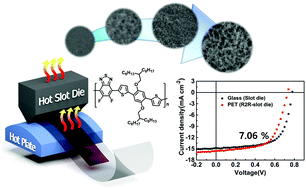Hot slot die coating for additive-free fabrication of high performance roll-to-roll processed polymer solar cells†
Abstract
Hot solution deposition has emerged as a promising strategy to achieve high performance polymer solar cells and many state-of-the-art devices have been recently fabricated by this approach in research laboratories. Currently, a major challenge in the photovoltaics community is translating such methodologies into industrially relevant processes so that progress can be made beyond the research community. In this work, hot deposition is developed via a slot die coating process, using a thermally robust and thickness tolerant photovoltaic polymer and a 3D printer-based slot die coater. This method uses not only hot substrates but also hot solutions. We find that controlling solution and substrate temperatures is critical to achieve optimum morphology and high device performance. Analysis of nano-morphology and molecular packing shows a clear influence of both solution and substrate temperatures. At optimal temperature conditions (80 °C head−80 °C substrate), slot die coated devices with an inverted configuration exhibited up to a 7.61% power conversion efficiency without using additives or other processing treatments, which are detrimental to stability and processing efficiency. The optimum temperature combination was readily scaled up using roll-to-roll processing equipment without further optimization, yielding flexible polymer solar cells with a 7.06% power conversion efficiency, demonstrating the potential of the hot slot die coating method from an industrial perspective.



 Please wait while we load your content...
Please wait while we load your content...